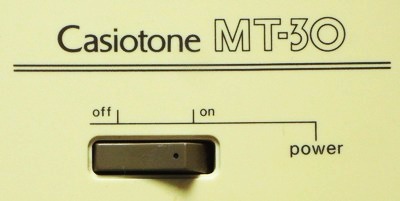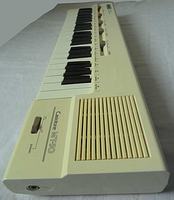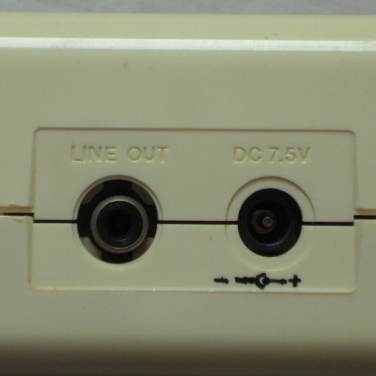 |
semi-analogue keyboard with unusual sound |
 |
 |
Also a brown version was made. Later a case variant with the speaker to the left was released as Casio MT-31.
| (old eBay photo) |  |
 |
This is definitely one of the very first midsize Casio keyboards, because unlike later MT series instruments it contains a heavy sheet metal frame that holds the keys, and also the slide switches and potentiometers are screwed to it and not only soldered to the PCB or held by grooves in the plastic case like in later small Casio instruments. Also the black keys of this ancient instrument have perfectly plain sides and not slanted ones like later midsize Casios.
Like Casio MT-60, the sounds of the MT-30 are quite bright and use apparently only 2 or 3 different filter settings. But in comparison to the MT-60 most sound preset of the MT-30 are rather boring attempts of imitating acoustic instruments, those as usual with squarewave instruments don't sound natural anyway (except with flute- like instruments), and by the lack of complex envelopes there are also no gimmicks like ringing mandolins. But due to the 2 suboscillators and filters they sound at least less plain than e.g. the timbres of a Letron. Due to the muffling filters, the bass range of many sound presets is too loud in comparison to simultaneous high notes. Interesting is that Casio named the only piano sound here "electric piano" - likely because they knew that this hardware can not imitate a piano well - however it sounds more like a sonorous e-bass anyway. Unusual is that the "cello" and "trumpet" fade silent when keys are held down. The "trumpet" could be also called "violin", it only sounds slightly brighter. The "st. ensemble" should likely mean "string ensemble", but resembles rather a mellow horn. The "brass" is a sort of trombone and turns into a sonorous tuba in the bass range. The "flute" and "recorder" only differ slightly at their beginning and the "folk flute" is a slightly brighter version. The "pipe organ" is quite harsh, the "organ" sounds a bit accordion- like and also the "oriental pipe" resembles high and bright accordion tones. The "guitar" resembles an electric one and the bass range of the "banjo" more a koto or harp. The "xylophone" and "glockenspiel" sound identical besides that the latter has a louder percussive start (more like a music box), while the "celesta" is slightly brighter, has no chorus effect and a longer decay phase, but all 3 sound quite similar. The only innovative sounds are "synthe fuzz" and "funny fuzz". The "synthe fuzz" resembles a rough bowed(?) sitar sound which fades brighter during the decay phase and is very dry and sonorous in the bass range. The "funny fuzz" is a sort of harp timbre with a mellower (less percussive) attack phase and consists of 2 notes (base note followed by 1 octave higher one) played with a very short delay.
When sustain is switched off, all sounds stop almost immediately after releasing the key, and the sound presets itself also contain neither vibrato nor tremolo. I like the MT-60 sounds more, but great is that also here when a key is trilled with sustain, each new note occupies a new sound channel, which produces a great phasing sound and volume increase effect although this eats up some polyphony.
Like with the ancient Casiotone 201, to select sound presets
the "mode" switch has to be moved from "play" to "set", which will also
assign the selected sound to the current position of the "tone memory"
switch. The sounds are then selected by white keyboard keys. Very interesting
is that the selected sound is played as a hint during the selection key
press, but only when the key is held down longer than about 0.2s. (It's
a pity that this trick is not used on average toy keyboards, because the
delay would make it possible to rapidly select OBS sounds during live performance
without hearing the selected sound, and despite easily test the sounds
by pressing the buttons slightly longer.) When the "mode" switch is set
back to "play", the keyboard behaves normal again (and the "tone memory"
switch can select between 4 of these sound presets during play). Like with
the Casiotone 201 only the white keys are used to select sounds;
possibly an external ROM chip with additional sounds for the black keys
was planned, because pressing any black keys apparently selects here an
empty sound because it mutes the keyboard. With the Casiotone 202
and also the MT-60 all continuous
tones (e.g. organs) are selected by one of the black keys while decaying
sounds (e.g. piano) are selected by the whites. After power on, the 4 "tone
memories" of the MT-30 always contain the sound presets {electric
piano, celesta, pipe organ, flute}.
circuit bending detailsThe case of the MT-30 is held close not only by screws, but also by nasty snap-in plastic tabs those either crack off while opening or (worse) cause a lot of scratches on the case rim when you try to lever the thing open with a screw driver after successfully removing all screws. (Once it is open, I recommend to intentionally crack off most of the tabs at the rear side, because otherwise you would scratch the case rim again and again even more when you every time need to poke around with the screw driver to open it.) Interesting is that inside the case the loudspeaker compartment is horizontally separated by a pressboard wall and damped with foam rubber mats, which I never found in other small keyboards. Unlike many other early Casio MT instruments, the main PCB of this one is rather small and fills only 1/3 of the case.The NEC D775G CPU is an early member of the D77xG family. It does not communicate with a host CPU but polls the keyboard matrix directly and outputs its digital audio bits through inverting drivers (3x "TC4049BP", 16 pin DIL) and a DAC made from a 12 pin resistor array and 7 individual resistors. Like with MT-60 and CT-410V the sounds consist of 2 mixed digital suboscillators with different stair shaped waveforms and digital volume envelopes, those are (depending on the preset) muffled by different filter capacitors. But while the latter use sophisticated envelope controls, the MT-30 uses for its 2 suboscillators only very simple attack- decay envelopes. In the bass range many sounds turn into a more or less buzzy, sonorous purring drone, which is a characteristic style element of squarewave based instruments. These basses can resemble some of the famous POKEY sound effects on Atari XL homecomputers and are very different from the gradually duller and duller growing sine wave bass behaviour of average Yamaha FM keyboard sounds. (For further technical details about Consonant-Vowel synthesis also see here.) The main voice hardware is identical with Casio MT-40 (verified in MT-31/ MT-40 service manual). The fixed filter is controlled through only CPU pin 46 IO-7. It turns lo (cutoff 1.1kHz) in preset sounds 'elec. piano' (1), 'brass' (12), cello (13), 'violin' (15), 'clarinet' (19), 'flute' (20), 'recorder' (21); all others stay hi (cutoff 1.4 kHz). The lower DAC bits can be tweaked with the "bit compensation" trimmer VR1. The service manual recommends a slightly complicated adjustment method: Connect one (triggering) channel of an oscilloscope to CPU pin 48 and the other (audio waveform) to pin 7 of op-amp 4558. Watch the waveform of 'celesta' and adjust for smoothest decay. But much easier (and almost as good) is to select 'celesta' and simply tweak for dullest timbre. If you like, you may install a potentiometer here as a distortion control. The waveforms of D775G are more complex than in Casiotone 201; particularly many sounds employ 2 different waveform halves or alternating cycles (one behind the other instead of addition) with different envelope speeds. So e.g. pluck noise is implemented by a negative short spike behind the rounder positive main wave halve. Many waveforms contain blank sections to make them buzzier. In preset sound selection the black keys show no waveforms at all. keyboard matrixThe keyboard matrix layout is generic for D77xG CPUs. Someone e-mailed me some info about additional keyboard matrix eastereggs, those are also explained in the bulletin "Modifying the Casiotone Instruments" by Robin Whittle.They are selected by each a locking switch in series to a diode at the following CPU pins:
CPU pin 17->27
CPU pin 16->26
CPU pin 17->31
CPU pin 17->25
CPU pin 16->25
CPU pin 16->31
CPU pin 18->29, 18->30
The MT-30 CPU also supports in total 49 keys, thus 12 lower note keys can be added as matrix eastereggs. However although the CPU supports them, these do not permit access to additional hidden preset sounds, but only select the default "electric piano" when pressed in sound selection mode. |
In reggae the MT-40 "rock" accompaniment pattern became famous in the "Sleng Teng" riddim - a background music track that appeared first in 1985 on King Jammy's record "Under Mi Sleng Teng".
The analogue percussion sounds really poor. The open cymbal of mine was such feeble that it was hard to notice until I knew (from MT-21) it was there. The snare lacked noise and only made a dull "propp". It is hard to estimate whether this percussion was intended to sound this way (early disco musics had strange muffled drumkits) or result of ageing components; but YouTube examples sound dull too, so it seems to be rather a feature. Fortunately this flaw is easy to fix. The warm analogue bass timbre resembles a dull Roland TB303 tone without resonance (made from very muffled squarewave) and has much of the bass accompaniments from the historical arcade videogame Donkey Kong. A brown version of this instrument was released as Casio MT-41.
Due to strong similarities with MT-30 I only list here the differences.
Interesting is also the very odd way the "fill-in" button behaves; unlike
all my other keyboards it does not play a complex pre- programmed drum
solo pattern by itself, but only replaces the rest of the current rhythm
bar with a simple drumroll pattern made from either 1/4 note base or 1/8
note snare hits (depending on the button press time) that extends to further
bars so long the button is held. These fill-ins sound basically just like
a fast going metronome and when the button is shortly released and pressed
again, it toggles between the 2 patterns "b---b---b---b---" and "s-s-s-s-s-s-s-s-",
thus less simple fill-ins can be played by pressing the button multiple
times.
circuit bending detailsUnlike Casio MT-30, the MT-40 contains an additional accompaniment CPU NEC D8048C-316, which outputs 5 trigger pulses for analogue drums, the bass tone and 2 bass envelope trigger signals. It apparently does not communicate with the main voice CPU, but it doesn't run (make short noises) with D8048C removed because it daisychains the clock signal.
There are 4 trimmers on the main PCB. VR1 is main voice bit compensation, which tweaks the DAC linearity. The others are for percussion decay; unfortunately there are none for cymbal and snare noise volume. The bass accompaniment with tone generator is obviously described in US patent 4561338. There it uses for each 2-bar bass pattern 16 ROM addresses (4 bit) with 5 bit bass note data (31=silence) and 5 bit percussion data (1 bit per sound). When during 2nd bar any chord key is pressed or held, the 4th address bit of the bass note counter resets and so repeats the 1st bar. The accompaniment CPU outputs a monophonic squarewave tone and trigger pulse for the analogue bass envelope circuit, and 5 separate trigger outs for analogue percussion. This patent even shows a crude concept drawing of the MT-40 with speaker to the right and chord buttons above the keys. rhythm & bass key matrixThe rhythm controls and bass key buttons are handled by the accompaniment CPU "NEC D8048C 316". The matrix input lines are routed through the inverter "4049-1" (Toshiba TC4049BP, 16 pin DIL) next to it, so its input pins need to be used. Although there are no exciting eastereggs, I add it here for the educational value, because it was so hard to understand how this matrix works.
The input lines are active-high, i.e. react on +Vs. Any functions can
be triggered by a non- locking switch in series to a diode from one "out"
to one "in" pin.
A higher note bass key can be added from IC 4049-1 pin 5 through a diode to pin 19 of the D8048C, but I found no additional preset rhythms. accompaniment shitshot buttonA lot of wild random crash sounds can be generated by adding a shitshot button from the unused D8048C pin 3 (2nd crystal input) against GND (for safety through a 1 kOhm resistor). In some crash states the thing plays on the bass buttons something like digital modem noises (no tone scale), in others it plays continuous irregular drum solos (like jungle grooves) those can be influenced by pressing bass button keys or switching the rhythm. Sometimes also chirping noises occur, those apparently abuse the drum trigger lines in odd ways.improve percussionAnalogue percussion has the reputation of sounding great, but this one doesn't. At least in my MT-40 the 'cymbal' was so faint that it was nearly inaudible and completely drowned in the mix. Also the noise part of the 'snare' was almost absent, so it made only a dull "propp" that had nothing common with an actual snare drum. I am not sure if it was really designed to sound this way or just a defect by ageing transistor noise circuits (there are no electrolytic capacitors involved); but others on YouTube seem similar, so it even may be that Casio muffled the percussion of this early model as a desperate measure to fight EM interference sensitivity.Fortunately this is easy to fix. To make the open cymbal louder, wire a trimmer (I used 100k) parallel to the 56nF capacitor near the lower left PCB rim. The snare consists of a layered sine wave tone and noise part with each an independent capacitor envelope circuit. The noise part is routed through a 150k resistor (one end marked with the test point "TP5 (SD)" on the PCB front). Desolder and replace it with a trimmer (at least 150k, I used 500k). Lowering resistance makes the noise part louder and brighter, and so dramatically improves the snare timbre. Like in later analogue Casio percussion (e.g. MT-65) it sounds surprisingly realistic. For sound control, instead of trimmers certainly also potentiometers can be installed, but regard that these circuits are extremely noise sensitive, so all parts need to be shielded and cables kept away from digital components and as short as possible to prevent picking up mains hum and HF interferences. Trimmers already exist for percussion decay: VR-2= base (default 15ms), VR3= claves (default 3.9ms) VR4= snare tone (default 7ms). The clave sounds more natural with VR3 turned brighter; unfortunately this also makes it too loud and distract from for the rest. pinout D8048C-316The Accompaniment LSI "NEC D8048C 316" (40 pin DIL) was Casio's most primitive accompaniment CPU. It supports a keyboard matrix for bass section and control panel, and has separate outputs for 5 analogue percussion triggers, but no chords (except arpeggiated patterns). It has only a monophonic bass channel made from a squarewave tone with envelope trigger out for an external analogue decay circuit with 2 duration settings.Technically the "D8048C xxx" is a generic microcontroller of the well documented Intel MCS-48 family, so everything it does is entirely controlled by software of its internal 1KB ROM (I dumped it). So it makes no sense to write down a combined pinout for all software variants of D8048C because they differ too much. This pinout describes software number "316", based on the Casio MT-40 service manual and Intel MCS-48 datasheets. This IC was used in Casio MT-40 and PT-7.
A variant with changed software is the "Toshiba
TMP8048P
1104" found in Casio MT-21
(compatibility verified by exchanging).
The tempo clock input to pin 6 is externally produced by a PUT (Programmable Unijunction Transistor) oscillator, which frequency depends on the tempo potentiometer. Rhythm can start only at the falling edge of it, therefore oscillation is forced into the next lo phase by a pulse from pin 35 to start rhythm immediately by a start button or bass key press (synchro start). Pin 36 halves the bass decay duration during 'rock' and 'slow rock' rhythm by externally bridging one of two serially wired capacitors with a transistor. Strange is why the input pins 32..34 are routed through an inverter. This really complicated understanding. Why didn't they simply invert the input or output lines in software?! Does the inverter stabilize the signal against stray capacitance and interferences, was the 1KB ROM too small or was this yet another hardware hotfix for a software bug inside the chip? Nevertheless, the MT-40 accompaniment section is the only Casio sound hardware that looks simple and yet well understood enough to be replicated either on an MCS-48 prototype board with some eproms or a simple software emulator. |
Another keyboard series with simple monophonic accompaniment and analogue
rhythm was the MC-2 hardware class (see Pan
Toys MC-7).
| removal of these screws voids warranty... | ||
 |
||
|
|